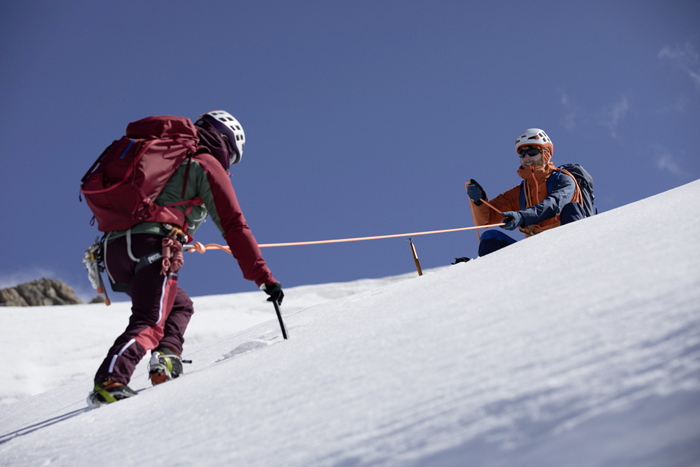


HIGH ALPINE TOURS: IMPORTANT KNOTS
All high alpine tourer should be familiar with key basic knots, so as to know how to deal appropriately with a range of situations. You should practice the knots until you can do them blindfold – after all, you may need to tie them in the dark, when tired or under time pressure.
There are three types of knot: Roping up knots, joining knots and safety knots or friction hitches.
Every knot causes a weakening of the rope or sling material. It must therefore be tied cleanly and precisely!
MUNTER HITCH
The Munter hitch is a type of safety hitch and is technically not a real knot, but rather a brake loop. It is used for protecting the leader and follower and when lowering a climbing partner, and works best in a pear-shaped HMS carabiner.
CLOVE HITCH
The clove hitch is also a type of self-locking loop. It is relatively simple to tie and untie and the ideal knot for personal anchoring. It is attached at the anchor’s center point using a locking carabiner. The length of the clove hitch can be set precisely and adjusted quickly: You pull on the center ridge of the knot and push the rope in the desired direction. Inconvenient untying or removal of your personal anchor becomes unnecessary.
FIGURE OF EIGHT LOOP
The figure of eight loop has been established as a standard knot for roping up and tying in. On a glacier tour you tie a figure eight loop for clipping into your harness using a locksafe carabiner. A follow-through figure eight is used for alpine climbing and tied directly to your harness.
PRUSIK
The Prusik is a friction hitch. It can be shifted when not under strain, but grips the rope when under tension. On high alpine tours, the Prusik is mainly used in crevasse rescues: Either as a climbing aid for self-rescue or as a reverse lock with a pulley system. The Prusik knot may also be used as a backup for the brake hand when rappelling. An accessory cord is wrapped two or three times – depending upon the rope thickness – around the rope(s). When rappelling the climber shifts the knot. The prusik hereby serves to protect the rappelling climber. An accessory cord of 5–6mm is usually used for a Prusik knot.
Butterfly knot
The butterfly knot is used as a brake knot because it is easy to untie after applying a load and it increases the braking effect on firn thanks to its unique shape. The butterfly knot is also one of the few knots that only marginally reduces the rope’s breaking strength.
DOUBLE OVER HAND KNOT
The double over hand knot is a large, bulky brake knot that can help arrest a fall by cutting into the lip of the crevasse.
HIGH ALPINE TOUR QUIZ: KNOT TECHNIQUES
A wide variety of knots are required for high alpine touring. If high alpine tourers wish to tour safely, they must know how to tie and use knots. Test what you have learned by taking this quiz: Can you pick the right knot for each situation?
Select the right answer.













